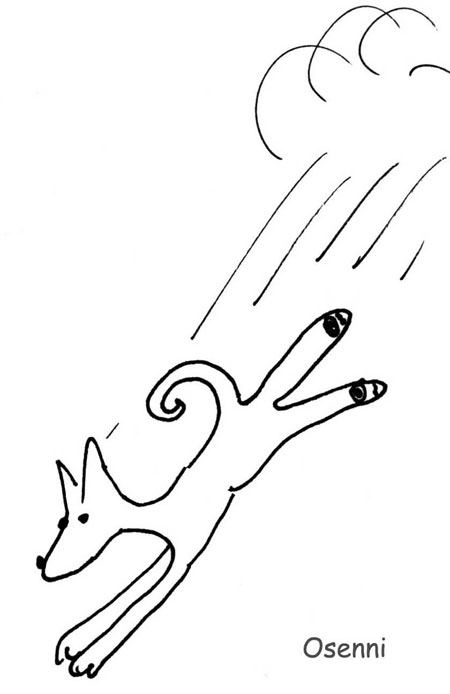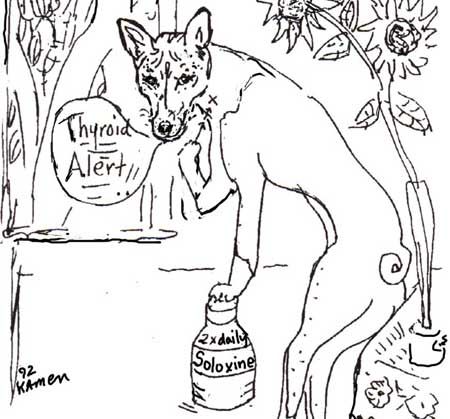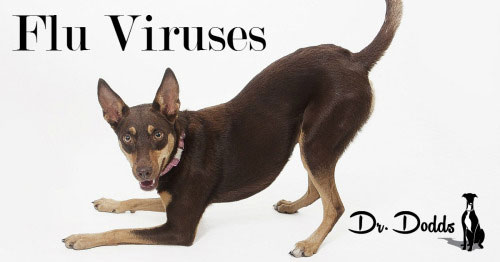Page 12 previous page > <next page>
SOME HEALTH & SCIENCE NEWS

A SURVEY OF CANINE IMMUNITY TO, AND VACCINES FOR, NEWER FLU VIRUSES
DR. JEAN DODDS' PET HEALTH RESOURCE BLOG
The 1918 influenza pandemic infected an estimated 500 million people worldwide and killed potentially 20 million people. In the United States, approximately 675,000 deaths were attributed to this particular virus, which originated in Europe and was carried throughout the world by troops returning home after World War I. It is important to remember that medical science was emerging and missteps were taken. For instance, influenza was not a reportable disease to public health officials at the time, medical doctors were scarce due to the war, doctors often thought it was the common cold, and some thought it was a bacteria causing the symptoms. But, I am not stating this to scare you into running out and getting vaccinated. The 1918 flu was hyper-virulent and mutated several times. Plus, we now have preventive and other measures in place, know more about healthy lifestyles and have a better healthcare system.
In 2008, a groundbreaking study was released about the 1918 pandemic. Eric Altschuler and a team of researchers gathered 32 survivors who were born before 1915. 94% of them (30 people) had produced antibodies that neutralized the 1918 flu virus. The scientists went further and found out that the gene sequence that encoded these antibodies had accumulated many mutations, which suggests that the cells had made further adaptations to similar viruses after 1918. This means they would more than likely not become ill if the 1918 virus cropped up again.
This study proved that naturally generated immunity can be lifelong in humans. At this time, we do not know if dogs have the same lifelong memory cell response to the two newer canine flu viruses, H3N2 and H3N8, because no long-term studies have been conducted at this point in time. I presume dogs would have lifelong immunity to influenza if it is naturally generated.
Researchers and scholars agree that naturally generated immunity is better than vaccine-induced immunity. In regards to influenza, vaccinated immunity is believed to last 2-3 years in humans. Now, let’s pretend that virus XYZ circulated in 2005 and reappeared in 2010. We have three healthy people in their 30’s: one person vaccinated in 2005 and 2010; one person never vaccinated; and, another vaccinated in 2005 but not in 2010. The person that was vaccinated both times will probably not become ill. The person never vaccinated will either become mildly ill or not ill at all since the body recognizes the virus. The person, who was only vaccinated in 2005, will more than likely become sicker than the other two since the body did not learn what to combat by natural exposure to the virus.
Why would the person never vaccinated possibly become just mildly ill? Influenza viruses need to change and mutate to survive. When the vaccine producers predicted that virus XYZ would be circulating again, they were able to adjust it for these potential changes.
As the Centers for Disease Control adroitly points out about flu vaccines, “Antibody elicited by vaccination is generally strain-specific, such that antibody against one influenza virus type or subtype confers limited or no protection against another type or subtype, nor does it confer protection against antigenic variants of the same virus that arise by antigenic drift.” In layman’s terms, influenza vaccines are very specific to the type (Influenza A), subtype (H3N2 and H3N8), and variances of viruses within those categories.
Herein lies the problem with companion animal influenza vaccines: they are generally not adapted for mutations after initial development.
In 2012, Pfizer Animal Health released a study it funded of its H3N8 vaccine which was isolated from dogs in Iowa in 2005. The researchers found that the Iowa vaccine was effective against more recent strains isolated from other parts of the country. However, the researchers noted, “The greatest amount of divergence correlated with the more recent isolates.“ Would the H3N8 vaccine still be efficacious in 2016 and beyond? We do not know. We would need to continually complete studies such as this annually.
These days, the headlines are focused on H3N2, which is the latest flu virus to be identified in dogs in the United States. It was isolated in Chicago, and the vaccine was fast-tracked through the United States Department of Agriculture. To date, there has been one challenge study that has proven that the H3N2 vaccine is efficacious. Then again, we do not know if it would prevent your companion dog from catching this strain of flu or not – no matter where he lives – because we do not know how fast the virus is changing or mutating. So, we do not know if the vaccine developed from Chicago dogs would be effective for the more recent outbreak in Atlanta.
You might be thinking to yourself, “Dr. Dodds, so you don’t think I should have my companion pets vaccinated?” As I always say, it depends on the pervasiveness, region, and the level of potential fatality of a disease. Please refer to the minimal vaccination protocol for my recommendations. In regards to influenza, you probably should allow nature to run its course since the symptoms are generally mild and the fatality rate is extremely low. Your pet will more than likely develop natural immunity that will help protect against further adaptations to similar viruses. If your pet was diagnosed with pneumonia in the past, then discuss whether the flu vaccine should be given in this case with your veterinarian and always take preventative measures.
W. Jean Dodds, DVM
Hemopet / NutriScan
11561 Salinaz Avenue
Garden Grove, CA 92843
References
Cureton, David K, et al. "An Inactivated H3N2 Canine Influenza Virus (CIV) Vaccine Aids in the Prevention of Clinical Disease and Virus Shedding in Dogs Challenged with Virulent H3N2 CIV.” The International Journal of Applied Research in Veterinary Medicine 14.2 (2016): 128-134. JARVM.com. Web. 2 Oct. 2016. http://www.jarvm.com/articles/Vol14Iss2/Vol14%20Iss2Cureton.pdf.
“The Great Pandemic: The United States in 1918-1919.” Flu.gov. U.S. Department of Health and Human Services, n.d. Web. 02 Oct. 2016. http://www.flu.gov/pandemic/history/1918/index.html.
Grohskopf, Lisa A., MD, et al. “Prevention and Control of Seasonal Influenza with Vaccines: Recommendations of the Advisory Committee on Immunization Practices – United States, 2013–2014.” Centers for Disease Control and Prevention, 20 Sept. 2013. Web. 02 Oct. 2016. http://www.cdc.gov/mmwr/preview/mmwrhtml/rr6207a1.htm.
Ledford, Heidi. “Remembrance of Viruses past." Nature.com. Nature International Weekly Journal of Science, 18 Aug. 2008. Web. 02 Oct. 2016. http://www.nature.com/news/2008/080818/full/news.2008.1045.html.
Oien, Nancee, BS, MS, et al. "Cross-Reactivity to Field Isolates of Canine Influenza by a Killed Canine Influenza Virus (H3N8, Iowa05) Vaccine." The International Journal of Applied Research in Veterinary Medicine 10.1 (2012): 14-18. Print. http://www.jarvm.com/articles/Vol10Iss1/Salmon1.pdf
A Brief on Ototoxicity, by "Amalia Roma,"
The Rip Van Wrinkler, November 2001
Lab of Auditory Neurophysiology
Dept. Biomedical Engineering
Johns Hopkins School of Medicine
Baltimore, MD
Certain therapeutic agents can cause functional impairment and cellular degeneration of the eighth cranial nerve and inner ear. These drugs are said to be “ototoxic” (or, toxic to the ear/hearing). The effects may be reversible (as with aspirin, antimalarial drugs, and loop diuretics like lasix) or irreversible (as with the aminoglycosides).
The aminoglycosides are a class of broad-spectrum antibiotics that can produce a profound and irreversible sensorineural hearing loss (SNHL).
Aminoglycoside antibiotics include (generic names):
· amikacin
· streptomycin
· neomycin
· gentamicin
· ribostamycin
· kanamycin
· tobramycin
· netilmicin
· dihydrostreptomycin
The general summary of ototoxic action is that first the outer hair cells of the basal turn in the cochlea are affected, followed by the other two rows of outer hair cells and inner hair cells. SNHL mostly affects high frequency hearing (so your dog may adjust and still be able to understand YOUR speech (human speech consists of many frequencies, including portions in the low frequency end) but may not react at all to a dog whistle.
With increased level of toxicity and/or particular sensitivity of individual animals may also produce “vestibulotoxicity,” or toxicity to the vestibular (balance) system. Symptoms include, but are not limited to, dizziness and loss of balance, nausea/vomiting (especially upon moving head), and nystagmus (involuntary eye movements which look “shifty”). To demonstrate an explanation of nystagmus, imagine spinning round and round and then stopping and trying to focus on an object straight ahead. You can actually DO this and may have see your kids do it!- your eyes still look like they are trying to track in the direction that you were spinning.
Aminoglycoside otoxicity/vestibulotoxicity is cumulative and permanent; many symptoms have not reached their full potential until after therapy is stopped (expect that if a dog starts to exhibit problems and therapy is stopped that it may get worse over the next two to three days because some of the drug is still circulating in the system and has not yet reached the hearing & balance systems).
Major risk factors for toxicity include:
· therapy lasting for more than 7 days
· elevated serum levels
· noise exposure (loud and/or long time course)
· prior use of aminoglycosides
· high dose (equal to or greater than 25mg/kg/day)
· young age (avoid using in neonates completely!)
· perforated ear drum (for aminoglycoside-containing ear drops)
To be safe, do not use aminoglycoside-containing eardrops at all and never use any form in young animals (especially neonates). Aminoglycoside use for topical applications and in the eyes is fairly safe because the actual amount of the antibiotic is so small that it has little or no consequence to the dog. Be very wary of systemic (injectable or oral) use, though, watching the dose and length of therapy carefully. These antibiotics are very good if used properly and, in some cases as a last resort in bad infections, there is a time to give in and go against the guidelines discussed above. If it is an absolute last resort drug, no others will work (always have your vet send out cultures for antibiotic sensitivity tests!!), you must go with systemic treatment. I’ve only personally run into one infection that required systemic gentamicin, as the bacteria was rapidly mutating and forming resistance to every antibiotic we tried. In most cases there are many choices for therapy that are just as effective and safer.
Always keep your meds out of your pet's reach.
I know this goes without saying but imagine having some topical cream with one of these antibiotics in it - the Basenji decides it will make good dental floss- and then you may run into serious problems.
A lot of people take for granted what may be in those topical creams. Read your triple antibiotic ointment tube’s contents. What’s that it has? Neomycin.

FDA Issues Warning Letters to Manufacturers of Unapproved Levothyroxine Drugs for Hypothyroidism in Dogs
FDA
U.S. Food and Drug Administration
Protecting and Promoting Your Health
January 29, 2016
The U.S. Food and Drug Administration has issued warning letters to six manufacturers of unapproved levothyroxine sodium drugs for hypothyroidism in dogs. These unapproved products have not been reviewed by the FDA for safety and effectiveness.
Thyro-Tabs Canine (levothyroxine sodium tablets), (NADA 141-448) is the only FDA-approved drug for replacement therapy for diminished thyroid function (commonly known as hypothyroidism) in dogs.
FDA is concerned about unapproved animal drugs. Animal drugs that have not been reviewed and approved by FDA may not meet FDA’s strict standards for safety and effectiveness. They also may not be properly manufactured or labeled.
FDA issued warning letters to manufacturers of the following unapproved levothyroxine products:
Thyrosyn
Soloxine
Levocrine
Thyromed
Thyroid Chewable Tablets
Thyrokare
Thyroxine L
Thyrovet
Leventa
If the companies that were issued the warning letters continue to market the violative products, they may be subject to enforcement action, including seizure of violative products and/or an injunction.
Shipments of levothyroxine active pharmaceutical ingredient (API) not referenced in an approved animal drug application or the subject of an index listing or a valid investigational use exemption and unapproved finished animal drugs containing levothyroxine offered for import may be subject to refusal.
Dog owners and veterinarians can report to the FDA any adverse events, including ineffectiveness, in dogs that received approved or unapproved hypothyroidism products. Information on reporting adverse events can be found at: http://www.fda.gov/animalveterinary/safetyhealth/reportaproblem/ucm055305.htm.
Warning Letters
Neogen Corporation
Quality Animal Care Manufacturing
Virbac Animal Health, Inc.
Dechra Veterinary Products LLC
Diamond Animal Health Inc.
Merck Animal Health

